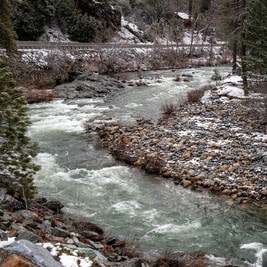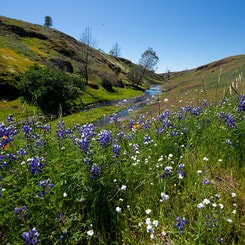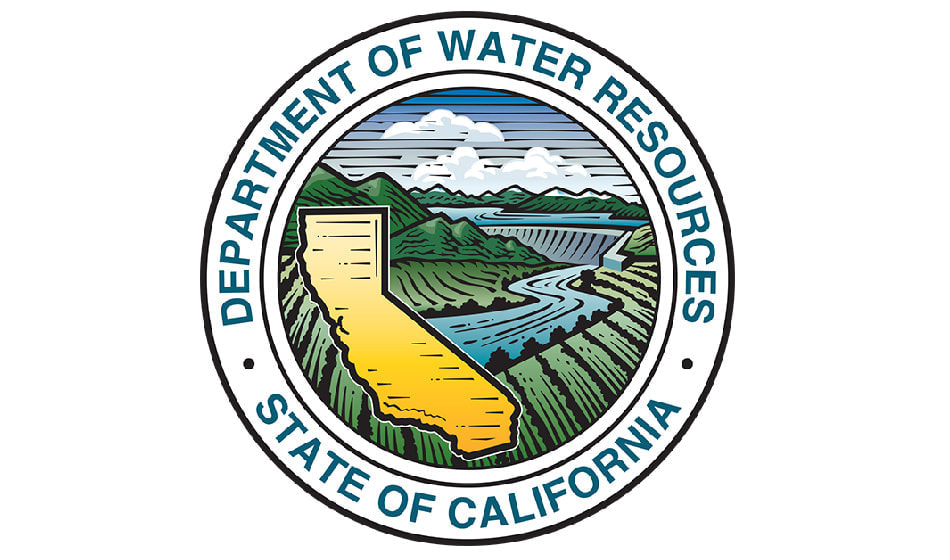 Lake Oroville Water Releases Continue The Department of Water Resources (DWR) continues to make releases from Lake Oroville using the main spillway at Oroville Dam. On Tuesday, DWR increased releases from Lake Oroville to the Feather River to assist with spring fish planting operations. Releases to the river will be further increased to 15,000 cubic feet per second (cfs) on Saturday and are expected to remain at this level through the weekend to account for higher inflow levels to the reservoir. The increase in water flow is performed to boost survival rates of spring-run Chinook salmon as they migrate from the Feather River to the ocean. Since March 16, DWR and the California Department of Fish and Wildlife (CDFW) have been releasing juvenile spring-run and fall-run Chinook salmon into the Feather River, including 880,000 spring-run Chinook salmon smolts released this week and an additional 500,000 fall-run Chinook salmon pre-smolts. Feather River releases are closely coordinated with the U.S. Army Corps of Engineers and downstream water operators. DWR continues to monitor lake inflow levels from spring snowmelt and will adjust releases accordingly. Since Dec. 1, Lake Oroville’s storage has increased more than 200 feet and gained 2 million acre-feet of water. The Lake Oroville reservoir is the largest storage facility in the State Water Project (SWP) and supports environmental and water delivery needs to 27 million Californians and reduces flood risks to downstream communities. DWR continues to monitor lake levels, weather forecasts, and mountain snow levels to optimize operations for water storage and environmental protection while allowing for carryover storage into next year.  WATER SAFETY With this season’s statewide snowpack at 237% of average as of April 3, California State Parks’ Division of Boating and Waterways (DBW), DWR and the California Department of Forestry and Fire Protection (CAL FIRE) are urging the public to take extra precautions and to be aware of cold-water dangers this spring to avoid a tragedy. The series of winter storms is causing rising river and stream flow levels not seen in years. The eventual spring warm-up will bring fast flows and cold temperatures when all that snow starts to melt. All Californians are being encouraged to wait until summer to recreate in the water, when conditions are safer. “California has one of the largest snowpacks on record,” said DWR Director Karla Nemeth. “As this snowpack melts in the coming months, the waterways will be especially cold, fast and running higher than normal. Be aware of fluctuating water levels. We want everyone to always make safety a top priority when recreating.” All three departments hope to educate not only regular water enthusiasts but occasional visitors to high, fast-running waterways who may venture near the edge to test the water or take selfies. Just one slip or unwatched child can become a devastating drowning statistic. Review key safety points to know before heading outside.  EARTH WEEK ACTIVITIES Celebrate Earth Week at the Lake Oroville Visitor Center April 17-21. Join our guides for fun, family-friendly activities throughout the week. Each day is an opportunity to show your love for our planet and its precious water through free fun activities, engaging story times, movies, or crafts. Located at 917 Kelly Ridge Rd in Oroville, the Visitor Center is open Monday through Friday from 9 a.m. to 5 p.m.
OROVILLE RECREATION Lake Oroville is one of the State Water Project’s premier recreational destinations and one of California’s best fishing spots. The lake provides both warm-water and cold-water fisheries. Below the Oroville Dam, the Thermalito Forebay, Thermalito Afterbay and the Feather River offer additional excellent fishing opportunities for Chinook salmon and steelhead. The marinas at Bidwell Canyon and Lime Saddle are open daily and provide a variety of services such as a shuttle and boat rentals. DWR, State Parks, and CDFW maintain over 92 miles of trails in the Oroville area. Paved trails at the Lake Oroville Visitor Center, Spillway Day Use Area, and at the North Forebay Day Use Area offer accessible trails with only slight elevation changes. Other trails, such as the Brad Freeman Trail near Oroville Dam, offer steep elevation changes to challenge hikers and mountain bikers. The Saddle Dam Trailhead has facilities for equestrians, including a large parking area to accommodate horse trailers, water troughs, and hitching posts, and easy access to trails designated for hikers and horses. An interactive map of recreation facilities, including open boat ramps, and their permitted uses (hike, bike, horse, multi) is available on DWR’s Lake Oroville Recreation webpage. A paper trail map is available at various locations, including most entrance kiosks and the Visitor Center. CURRENT LAKE OPERATIONS Lake Oroville is at 870 feet elevation and storage is approximately 3.08 million acre-feet (MAF), which is 87 percent of its total capacity and 118 percent of the historical average. The Feather River releases are at 10,500 cubic feet per second (cfs). Flows through the City of Oroville are 3,700 cfs with 7,800 cfs released from the Thermalito Afterbay Outlet (Outlet) for a total of 10,500 cfs downstream of the Outlet. Releases to the Feather River will increase to 15,000 cfs on Saturday with flows of 3,500 cfs through the City of Oroville. DWR continues to assess releases to the Feather River daily. The public can track precipitation, snow, reservoir levels, and more at the California Data Exchange Center. The Lake Oroville gage station is identified as “ORO”. All data as of midnight 4/13/2023. Comments are closed.
|
Archives
October 2023
Categories
All
|


 RSS Feed
RSS Feed